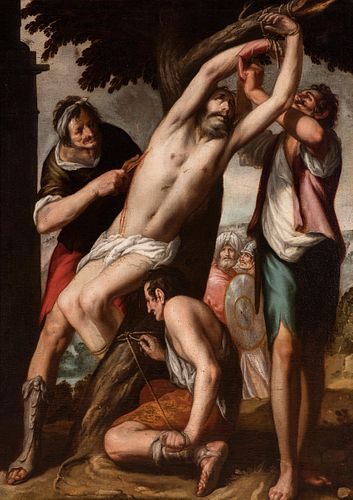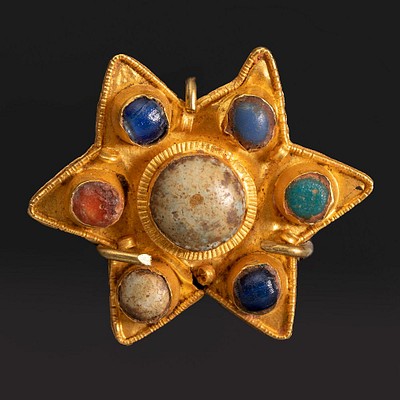ANTONIO DEL CASTILLO Y SAAVEDRA (Cordoba, 1616 - 1668). "The Martyrdom of St. Bartholomew". Oil on canvas.
Lot 72
About Seller
Setdart Auction House
Carrer Aragó 346
Barcelona
Spain
Setdart Subastas was born in 2004 and is currently the first online art auction in Spain with solidity, prestige and reliability guaranteed by our more than 60,000 users. Setdart has a young, dynamic and enterprising team ready to successfully manage the purchase and sale of art works through custom...Read more
Estimate:
EUR€20,000 - EUR€22,000
$21,505.38 - $23,655.91
Absentee vs Live bid
Two ways to bid:
- Leave a max absentee bid and the platform will bid on your behalf up to your maximum bid during the live auction.
- Bid live during the auction and your bids will be submitted real-time to the auctioneer.
Bid Increments
| Price | Bid Increment |
|---|---|
| EUR€0 | EUR€10 |
| EUR€200 | EUR€25 |
| EUR€500 | EUR€50 |
| EUR€1,000 | EUR€100 |
| EUR€3,000 | EUR€200 |
| EUR€5,000 | EUR€500 |
| EUR€10,000 | EUR€1,000 |
| EUR€20,000 | EUR€2,000 |
| EUR€50,000 | EUR€5,000 |
About Auction
By Setdart Auction House
Dec 21, 2021
Set Reminder
2021-12-21 07:30:00
2021-12-21 07:30:00
America/New_York
Bidsquare
Bidsquare : Córdoba: 2,000 Years of Art
https://www.bidsquare.com/auctions/setdart-auction-house/c-rdoba-2-000-years-of-art-8049
Setdart Auction House sofia@setdart.com
Setdart Auction House sofia@setdart.com
- Lot Description
ANTONIO DEL CASTILLO Y SAAVEDRA (Cordoba, 1616 - 1668). "The Martyrdom of St. Bartholomew". Oil on canvas. Measurements: 138 x 99 cm; 165 x 125 cm (frame). Work that represents St. Bartholomew being martyred, the author places the protagonist in the center of the composition that follows a triangular pattern of classical character. This allows an easy reading of the theme represented. It is worth mentioning the treatment of color, with a palette of bright and saturated colors that brings expressiveness to the work, thus harmonizing with the theme represented.Bartholomew was one of the apostles of Jesus, and is mentioned in the Gospels always in the company of Philip. According to John, in whose Gospel he appears under the name of Nathanael, he was one of the disciples to whom Jesus appeared at the Sea of Tiberias after his resurrection. According to the Acts of the Apostles, he was also a witness to Jesus' ascension. The tradition collected by Eusebius of Caesarea narrates that Bartholomew went to preach the Gospel in India, where he left a copy of Matthew's Gospel in Aramaic. The Armenian tradition also attributes to him the preaching of Christianity in the Caucasian country, together with St. Jude Thaddeus, so both are considered patron saints of the Armenian Apostolic Church. Their martyrdom and death are attributed to Astiages, king of Armenia and brother of King Polymius, whom the saint had converted to Christianity. As the priests of the pagan temples, who were running out of followers, protested to Astiages against the evangelizing work of Bartholomew, the ruler sent for him and ordered him to worship their idols, as he had done with his brother. Faced with the saint's refusal, the king ordered him to be flayed alive in his presence until he renounced God or died. The image of Saint Bartholomew has undergone few modifications throughout the history of art, being common the representation of the saint at the moment of martyrdom. Thus, he is represented being flayed, either on a colt or tied to a tree. He has also been represented working miracles: resuscitating the children of King Polymius and freeing his daughter possessed by the devil. On rare occasions he appears being scourged. Sometimes he is represented with a large knife alluding to his martyrdom, according to which he was flayed alive, which is why he is the patron saint of tanners. Also in relation to his martyrdom he is sometimes depicted skinned, showing his skin held in his arm as if it were a piece of clothing. In the Baroque period it will be common to see him represented as an apostle, with a long white cloak, making the Holy Scriptures and showing the knife. Antonio Castillo is considered the father of the Cordovan school, known for his work as a painter, he was also a polychromator and designer of architectural, decorative and goldsmith projects. He was the son of Agustín del Castillo, a little known painter from Llerena (Extremadura) whom Palomino describes as "an excellent painter". It is also believed that he may have trained as a polychromator in Calderón's workshop. However, he was orphaned when he was only ten years old, in 1626, and went on to develop his training in the workshop of another painter of whom we have no news, Ignacio Aedo Calderón. Although there is no real evidence of this, it is believed that he may have arrived in Seville, where, according to Palomino, he entered Zurbarán's workshop. This has been corroborated by the stylistic influence of the master from Extremadura that historians have seen in Castillo's work. However, in 1635 he was back in his native Cordoba, where he married and settled permanently, to finally become without discussion the most important artist of the city. His fame and quality earned him important commissions, including religious altarpieces, portraits and medium-sized series. He was also the teacher of outstanding Cordovan painters of the following generation, such as Juan de Alfaro y Gámez.
- Shipping Info
-
In-house shipping available. Please inquire at admin@setdart.com.
-
- Buyer's Premium



 EUR
EUR CAD
CAD AUD
AUD GBP
GBP MXN
MXN HKD
HKD CNY
CNY MYR
MYR SEK
SEK SGD
SGD CHF
CHF THB
THB

















